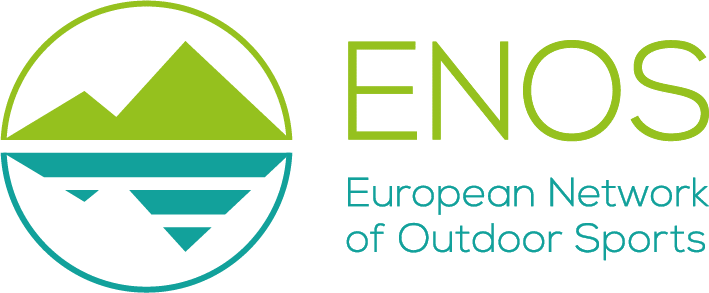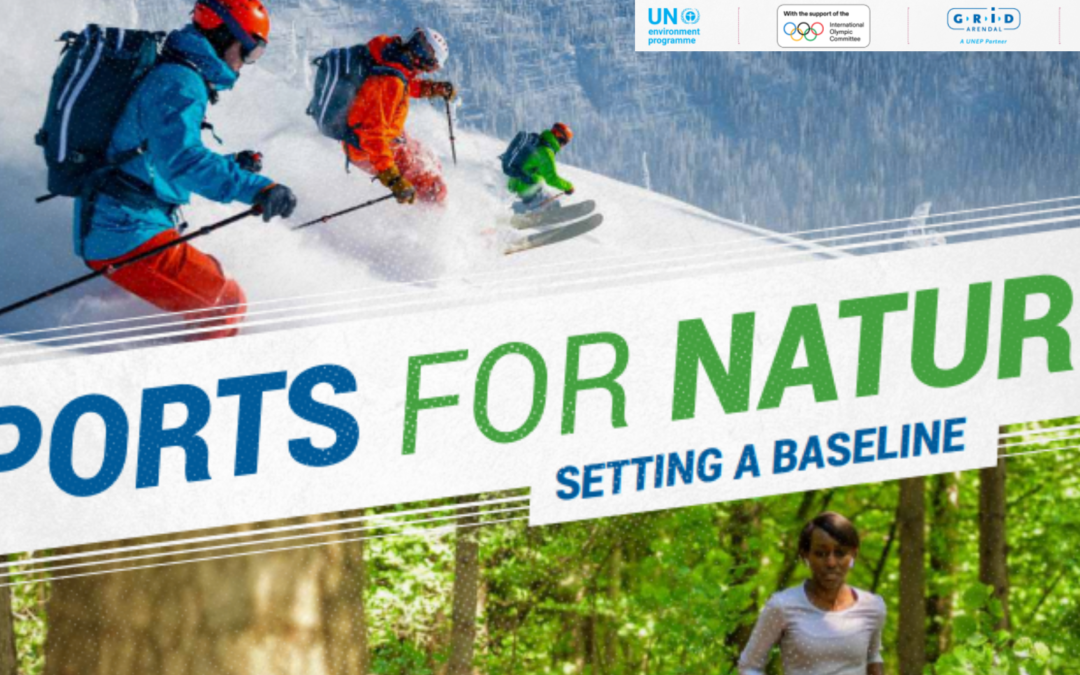Inspired by the UNFCCC’s Sport for Climate Action Framework (2018), along with IUCN and IOC’s guidance, and in support of the nature MTS pillar, the UN Decade on Ecosystem Restoration, the post-2020 Biodiversity Framework and the Sustainable Development Goals, the Sports for Nature: Setting a Baseline handbook will support sport to be a critical partner for change.
THE’SPORTS FOR NATURE HANDBOOK HAS BEEN LAUNCHED
This joint initiative by the UN Environment Programme with the support of the International Olympic Committee, along with Loughborough University and GRID Arendal has enabled the creation of a handbook identifying the place of sport in nature and the impacts resulting from the development of different sport disciplines, including their value chains, infrastructure and events. Against the backdrop of the triple global crises of climate change, pollution and biodiversity loss, the document provides a framework that highlights the urgency, dependency and impact of the sport sector in order to highlight actions that can be taken to improve environmental mitigation and conservation. A series of initiatives and case studies are presented in support of the document, illustrating current efforts by sport organisations around the world to partner with conservation organisations to halt the deterioration of natural areas vulnerable to sport impacts.
THE ROLE OF OUTDOOR SPORTS
Despite being a document addressed to a large audience within the sport sector, Outdoor Sports are well represented by the affinity of the subject, concerned by the effects of the ecological crisis and being a regular witness of its impacts on the landscape, but also through a number of particular mentions that give them a role within the framework :
“Outdoor sports immerse the participant in the natural environment and rely on clean air, clean water, and healthy spaces for safe play. For many generations, sport managers and participants have taken the natural environment for granted (Orr and Inoue 2019), developing complex dependencies in their supply chains, schedules, and systems which assume the natural environment will go unchanged. The full enjoyment of the environment is also not equal for everyone as other factors such as disability, gender, race, socio-economic status and geographical location also impact to what extent one interacts with the environment. This report reviews how sport’s intimate relationship with nature might be leveraged for actions to address nature loss, and how sport organisations can become central partners in supporting nature-based work in their communities.” (Sports For Nature Handbook, 2022)
Organisations
Sports
Countries
3 KEY QUESTIONS
The research on which this paper is based conducted focus groups with 109 sport organisations in 30 different sports and 48 countries. This allowed a survey to be carried out on the position of the different actors on the issue of the global crisis and the position of sport in relation to it, taking into account both dependency and impacts. To this end, three main questions were used as the basis for the discussion:
- Do sport organisations see nature to be important?
- What is sport currently doing to address environmental issues?
- What capacities do sport organisations have to address environmental issues?
The responses allowed a number of preliminary considerations to be made:
Nature is important: Participants agreed that nature is important but were unclear on what role their organisations might play in protecting it and what tools were available to them.
Climate comes first: Reducing emissions is the current objective, while efforts to address wider environmental issues are piecemeal, at best.
Show me how: While interest is high, practical knowledge among sport managers is low, and much remains unknown about biodiversity loss and pollution.
This will require resources: The key barrier preventing further action among sport organisations is a lack of internal resources: insufficient funding, lack of dedicated human resources, and poor institutional knowledge on nature topics.
“A GAME PLAN FOR SPORT”
Taking into account these insights in relation to the level of awareness of the nature importance, climate change as a priority and the need for practical knowledge and resources, the Sports for Nature document offers a guide to start assessing the impact of sports organisations in order to develop an appropriate mitigation and adaptation strategy:
1 – Set a baseline for nature
“The first major opportunity for sport organisations to address nature is to review their site (or the places they play, if not directly managed by the organisation) and operations and take stock of any pollution caused by their activities, plastic pollution, outdated or unkempt facilities that may be having negative impacts on nature, any particularly run-down or overused areas of terrain affecting existing ecosystems, and use of synthetic pesticides, herbicides and other chemicals on site, and impacts caused by their activities.”
ENOS contribution: The first step in managing impacts is to identify them in order to target the problem at the source, allowing sustainable solutions to be implemented. Through the SEE (Sustainability and Environmental Education) project, a series of reports have been developed identifying the impacts associated with different outdoor sports through a survey of protected areas and sports federations in Europe. On the SEE website you can find all the reports related to sustainable development, impact and perception for the outdoor sector.
2 – Align with the Mitigation and Conservation Hierarchy
Avoid: Avoiding negative impacts on nature.
Reduce: Minimizing the harm caused by any unavoidable impacts.
Restore: Working to improve damaged ecosystems.
Renew: Contribute to proactively creating ecosystems, such as artificial reefs.
ENOS contribution: While the first two objectives have been addressed through different actions such as the publication of the policy position paper on the European Green Deal, the signing of the UNFCCC climate change framework, and the publication of the strategic priorities, the challenge of implementing measures for the restoration and renovation of natural areas remains a challenge for the sector. We need to do more, as evidenced by the words of Hans Brunyck, Executive Director of the European Environment Agency, during EuroMeet 2022 when he argued that “restoration is the way forward for the outdoor sector to provide a unique response from the world of sports”.
3 – Work with others
“Environmental knowledge is already plentiful among eager stakeholders waiting to be activated by sport organisations and events. These stakeholders may include: local governments, sponsors, volunteers, environmental non-profit organisations, consultants, and academics, among others.“
ENOS contribution: The objective and mission of ENOS as a network is to be able to connect the different members with each other to exchange best practices, develop projects and leverage potential synergies. By creating a link between political institutions and grassroots organisations as well as the research sector and training organisations, ENOS is able to strategically represent the sector, share knowledge and provide members some guidance on capacity building. The environmental sector is now a key partner in the development of European public policies, as evidenced by the existing partnerships with environmental non-profit organisations.
4 – Educate and advocate for nature
“Perhaps the most significant opportunity for sport to take action for nature is to educate its vast audience of sport fans and participants, its partners, and its broad supplier network on nature issues. It’s also critical for sport organisations to leverage their position to support awareness-raising campaigns that will galvanize their network to advocate for solutions with governments and decision-makers.”
ENOS contribution: As outdoor enthusiasts, we at ENOS have seen the power of outdoor sports as a multiplier when it comes to transmitting a message that allows us to adapt our activites to the necessary ecological transition. Through different European projects such as BOSS or SEE, we have been able to demonstrate the usefulness of sport as a social and educational tool. For this reason, the SEE project, with a duration of three years, aims to produce a toolkit with a series of pedagogical resources for trainers and other stakeholders in charge of the environmental education in the field.
The conclusions of the handbook are closed by three recommendations or next steps as priorities for the sports sector to become key role-players in the global strategy to address the triple planetary crisis and become nature positive:
Co-create a new framework for action with sport
Convene working groups to implement action for nature
Share, translate and coordinate information
DOWNLOAD THE HANDBOOK
To find out more about the recommendations, case studies, initiatives and much more, access the full document in the official UNEP website or download it directly here:
“As our ecosystems offer the water, air, food, and materials that support all life on Earth, biodiversity loss is a critical threat to all activities, including sport. In fact, without a healthy natural environment, sport simply cannot function. And yet, despite the availability of some guidance on biodiversity actions in sport, little has been done to address these issues on a systematic scale. The solutions to climate change include mitigation (i.e. reducing emissions to prevent worsening climate conditions) and adaptation (i.e. developing response strategies to alleviate harm caused by climate change in the present and future).” (Sports For Nature, 2022)
Global consultation on the Draft Sports for Nature Framework
Outdoor Sport stakeholders feedback is greatly appreciated and will be taken on board, as the authors are preparing the final Sports for Nature Framework for launch on 16 December, at the Convention on Biological Diversity Conference of the Parties in Montreal.
In case you have not had a chance yet to provide feedback or would like to share this information with other interested parties, you can access here the link to the Draft Framework and Feedback Form. In addition, here you can find a brief presentation on the Draft Framework from the consultation.
Please note that the deadline for feedback is Wednesday, 30 November 2022, when the last in-person consultation on the Framework will be holded.

